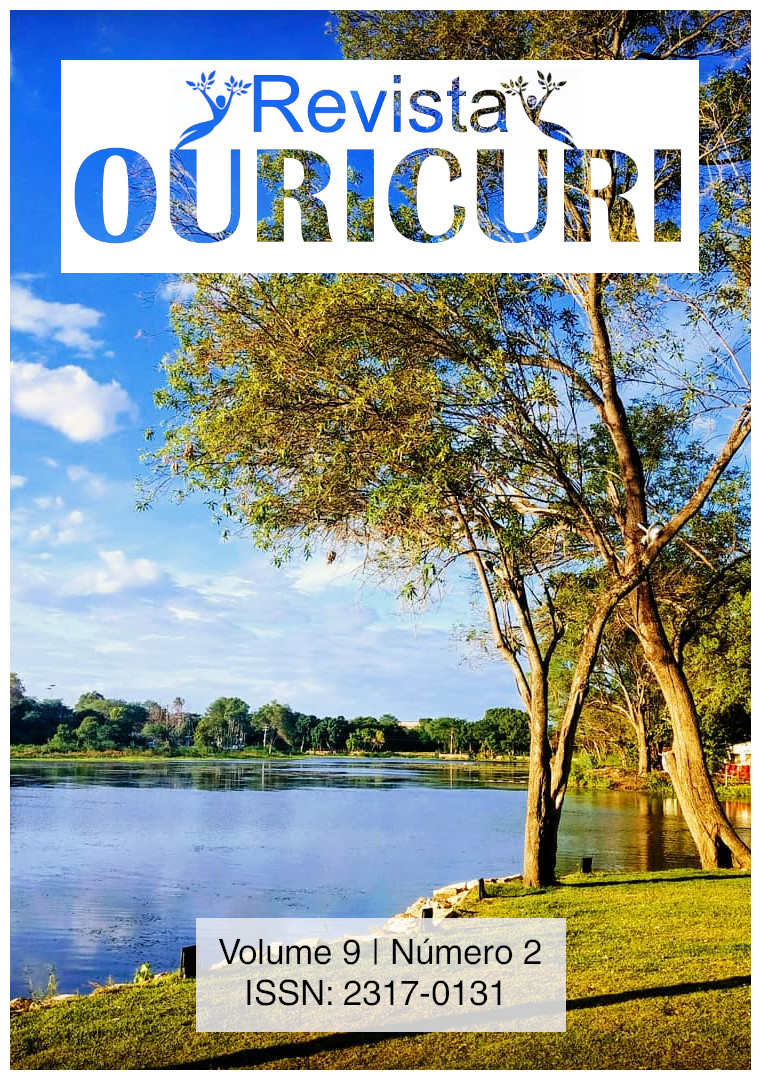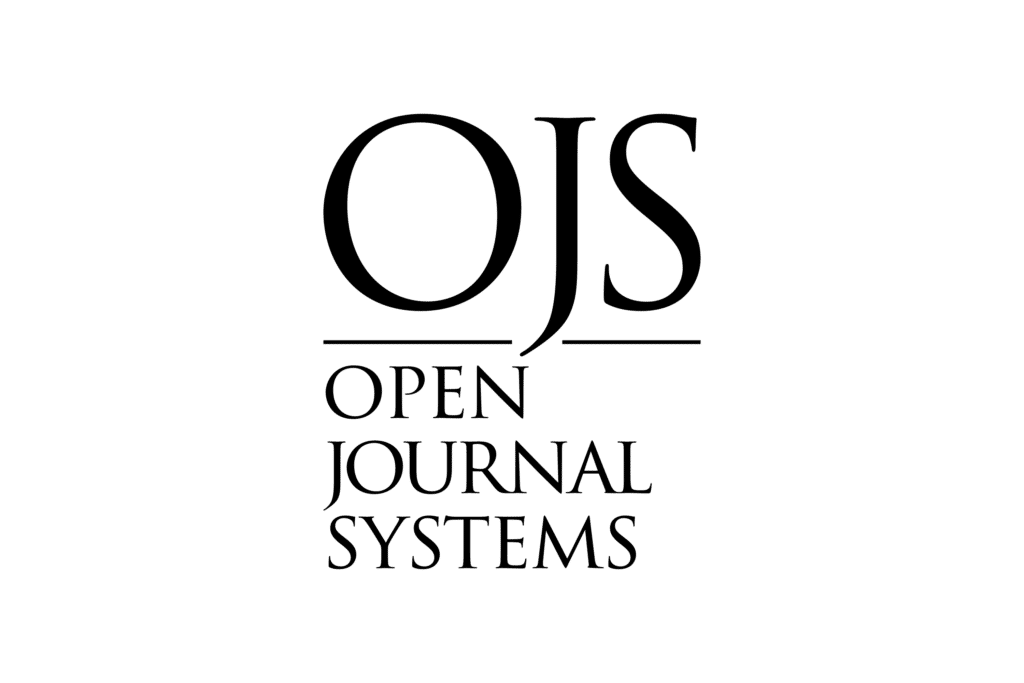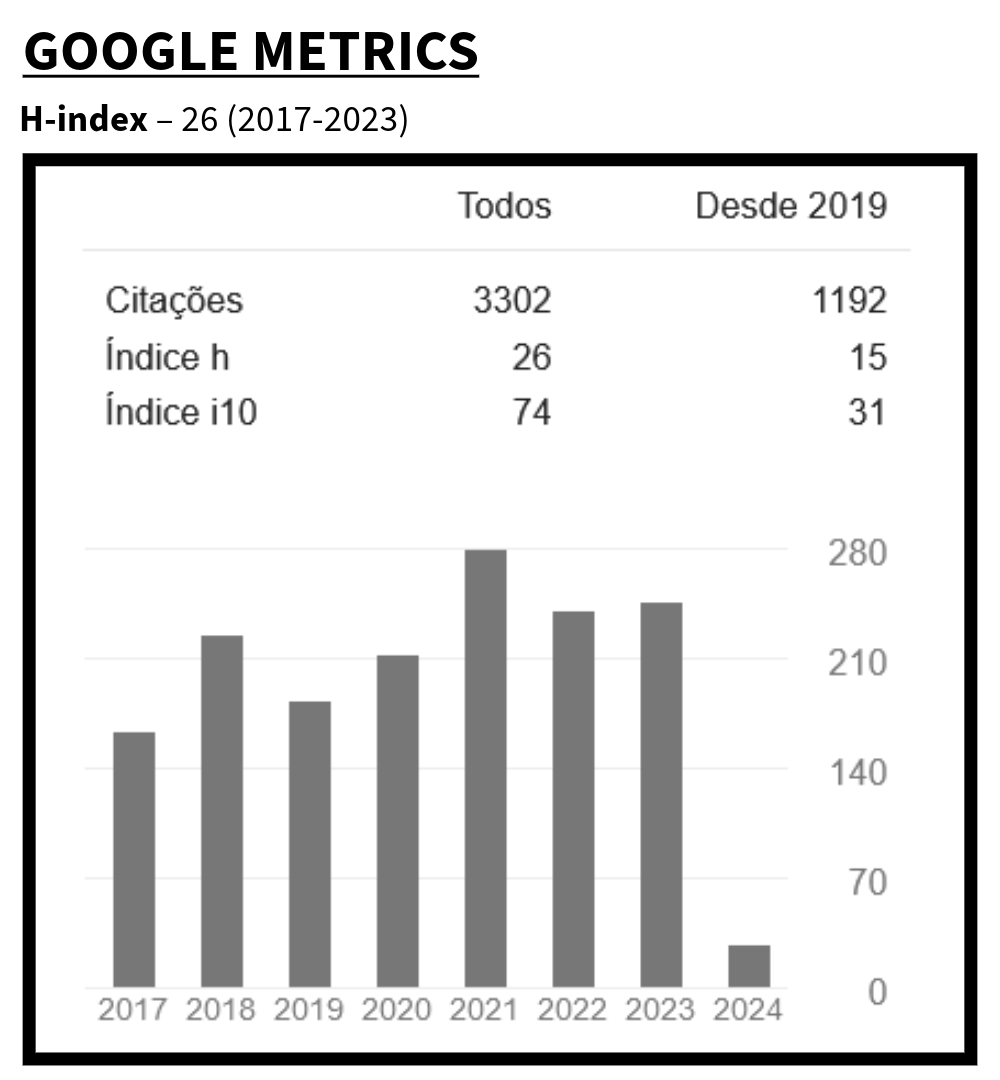BIOMETRY AND NON-DESTRUCTIVE ALLOMETRIC MODEL FOR ESTIMATING BABASSU (Attalea speciosa) FRUIT VOLUME AND DENSITIES
DOI:
https://doi.org/10.59360/ouricuri.vol9.i2.a7041Palavras-chave:
Allometry, Fruit Shape, Ellipsoid Fruits.Resumo
Biometric data of fruits, such as volume and density, can be applied for different ecological and economic purposes. Non-destructive allometric models based on morphometric dimensions can be more accurate and practical in field conditions than destructive methods used in traditional growth curves. Babassu is a Brazilian native palm tree with wide distribution whose fruits are of high importance for socioeconomic and cultural purposes, in addition to having high potential for biodiesel production. The objectives of this work were to analyse morphometric and biometrically the babassu fruits and create a non-destructive allometric model to estimate their volumes and densities from their dimensions. Weight, polar and longitudinal diameters, volume and density were measured in 156 fruits. The dimensions were applied in the formula to estimate the volume of an ellipsoid object, which matches the shape of the babassu fruit. The non-destructive allometric model was created by calculating a correction factor to adjust the precision of the formula. Our model improved the accuracy of volumes and densities calculated by 24%. Strong correlations were also found between the morphometric and biometric parameters. Therefore, this allometric model can be used to assist in selecting the most suitable fruits to improve economic, propagation and conservation studies.Downloads
Referências
Bouaid, A.; El Boulifi N.; Martínez, M.; Aracil, J. Biodiesel Production from Babassu Oil: A Statistical Approach. Journal of Chemical Engineering & Process Technology, 6(3), 1-4, 2015. DOI 10.4172/2157-7048.1000232.
Bozokalfa, K.; Kilic, M. Mathematical modeling in the estimation of pepper (Capsicum annuum L.) fruit volume. Chilean Journal of Agricultural Research, 40(5), 626-632, 2010.
Campos, J. L. A.; Silva, T. L. L.; Albuquerque, U. P.; Peroni, N.; Araújo, E. A. Knowledge, Use, and Management of the Babassu Palm (Attalea speciosa Mart. ex Spreng) in the Araripe Region (Northeastern Brazil). Economic Botany, 69(3), 240-250, 2015. DOI 10.1007/s12231-015-9315-x.
Carrazza, L. R.; Ávila, J. C. C.; SIlva, M. L. Manual tecnológico: Aproveitamento integral do fruto e da folha do babaçu. Brasília/DF: Instituto Sociedade, População e Natureza (ISPN), 2012.
Ciconini, G.; Favaro, S. P.; Roscoe, R.; Miranda, C. H. B.; Tapeti, C. F.; Miyahira, M. A .M.; Bearari, L.; Galvani, F.; Borsato, A. V.; Colnago, L. A.; Naka, M. H. Biometry and oil contents of Acrocomia aculeata fruits from the Cerrados and Pantanal biomes in Mato Grosso do Sul, Brazil. Industrial Crops and Products, 45, 208-214, 2013. DOI 10.1016/j.indcrop.2012.12.008.
Godoy, C.; Monterubbianesi, G.; Tognetti, J. Analysis of highbush blueberry (Vaccinium corymbosum L.) fruit growth with exponential mixed models. Scientia Horticulturae, 115(4), 368-376, 2008. https://doi.org/10.1016/j.scienta.2007.10.018.
Hahn, F.; Sanchez, S. Carrot volume evaluation using imaging algorithms. Journal of Agricultural and Engineering Research, 75(3), 243-249, 2000. https://doi.org/10.1006/jaer.1999.0466.
Hall, A. J.; Mcpherson, H. G.; Crawford, R. A.; Seager, N. G. Using early-season measurements to estimate fruit volume at harvest in kiwifruit. New Zealand Journal of Crop and Horticultural Science, 24(4), 379-391, 1996. https://doi.org/10.1080/01140671.1996.9513975.
IBGE. Produção da Extração Vegetal e da Silvicultura. 2020. Available at: https://sidra.ibge.gov.br/tabela/289. Acesso em: 06 de mai. 2020.
Jorquera-Fontena, E.; Génard, M.; Ribera-Fonseca, A.; Franck, N. A simple allometric model for estimating blueberry fruit weight from diameter measurements. Scientia Horticulturae, 219, 131–134, 2017. DOI 10.1016/j.scienta.2017.03.009.
Leitman, P.; Soares, K.; Henderson, A.; Noblick, L.; Martins, R.C. Arecaceae in Lista de Espécies da Flora do Brasil. Jardim Botânico do Rio de Janeiro, 2014. Disponível em: <http://floradobrasil.jbrj.gov.br/jabot/floradobrasil/FB15686>.
Lima, J. R.; Silva, R. B.; Silva, C. C.; Santos, L.; Moura, E.; Moura, V. Biodiesel de babaçu (Orbignya sp.) obtido por via etanólica. Química Nova, 30(3), 600-603, 2007.
Machado, R.C.R.; Almeida, H.A. Estimativa do volume do fruto de cacau. Revista Brasileira de Fisiologia Vegetal, 1(1), 115-117, 1989.
Martínez, I.; García, D.; Obeso, J. R. Allometric allocation in fruit and seed packaging conditions the conflict among selective pressures on seed size. Evolutionary Ecology, 21, 517-533, 2007.
Mitja, D.; SILVA, J. C. S.; Melo, S. L.; Filho, H. C. Biometria dos frutos e sementes de babaçu, Natividade - TO. In: IX Simpósio Nacional Cerrado, II Simpósio Internacional de Savanas Tropicais, 2008. p. 8.
Olver, F. W. J.; Lozier, D. W.; Boisvert, R. F.; Clark, C. W. NIST Handbook of Mathematical Functions. Cambridge: Cambridge University Press, 2010.
Omid, M.; Khojastehnazhand, M.; Tabatabaeefar, A. Estimating volume and mass of citrus fruits by image processing technique. Journal of Food Engineering, 100 (2), 315–321, 2010. DOI 10.1016/j.jfoodeng.2010.04.015.
Pérez-Harguindeguy, N.; Diaz, S.; Garnier, E.; Lavorel, S.; Poorter, H.; Jaureguiberry, P.; Bret-Harte, M. S. S.; Cornwell, W. K. K.; Craine, J. M. M.; Gurvich, D. E. E.; Urcelay, C.; Veneklaas, E. J. J.; Reich, P. B. B.; Poorter, L.; Wright, I. J. J.; Ray, P.; Cornelissen, J. H. C. New Handbook for standardized measurment of plant functional traits worldwide. Australian Journal of Botany, 61 (34), 167–234, 2013. DOI http://dx.doi.org/10.1071/BT12225.
Protásio, T. P.; Truguilho, P. F.; César, A. A. S.; Napoli, A.; Melo, I. C. N. A.; Silva, M. G. S. Babassu nut residues: potential for bioenergy use in the North and Northeast of Brazil. SpringerPlus, 3(124), 1-14, 2014. DOI 10.1186/2193-1801-3-124.
Protásio, T. P.; Guimarães Junior, M.; Mirmehdi, S.; Trugilho, P.F.; Napoli, A.; Knovack, K.M. Combustion of Biomass and Charcoal Made From Babassu Nutshell. Cerne, 23(1), 1-10, 2017. DOI 10.1590/01047760201723012202.
Radovich, T. J. K.; Kleinhenz, M. D. Rapid Estimation of Cabbage Head Volume across a population Varying in Head Shape: A Test of Two Geometric Formulae. HortTechnology, 14 (3), 3-6, 2004.
Santos, D. S.; Silva, I. G.; Barbosa, M. C. L.; Nascimento, M. D. S. B.; Costa, M. C. P. Parâmetros de qualidade físico-química de óleos e análise morfométrica de frutos e sementes da espécie Orbignya phalerata Martius por região ecológica. Eclética Química Journal, 41(1), 74-84, 2016.
R Development Core Team. R: Language and Environment for Statistical Computing. Vienna, Austria, 2019. Available at: http://www.r-project.org/index.html.
Tijskens, L. M. M.; Unuk, T.; Okello, R. C. O.; Wubs, A. M.; Šuštar, V.; Šumak, D.; Schouten, R. E. From fruitlet to harvest: Modelling and predicting size and its distributions for tomato, apple and pepper fruit. Scientia Horticulturae, 204, 54-64, 2016. https://doi.org/10.1016/j.scienta.2016.03.036.
Zimmerman, J. K.; Weis, I. M. Fruit size variation and its effects on germination and seedling growth in Xanthium strumarium (Ontario). Canadian Journal of Botany, 61(9), 2309-2315, 1983. https://doi.org/10.1139/b83-253.
Downloads
Arquivos adicionais
Publicado
Como Citar
Edição
Seção
Licença
Autores que publicam nesta revista concordam com os seguintes termos:
a. Autores mantém os direitos autorais e concedem à revista o direito de primeira publicação, com o trabalho simultaneamente licenciado sob a Licença Creative Commons Attribution que permite o compartilhamento do trabalho com reconhecimento da autoria e publicação inicial nesta revista.
b. Autores têm autorização para assumir contratos adicionais separadamente, para distribuição não-exclusiva da versão do trabalho publicada nesta revista (ex.: publicar em repositório institucional ou como capítulo de livro), com reconhecimento de autoria e publicação inicial nesta revista.
c. Autores têm permissão e são estimulados a publicar e distribuir seu trabalho online (ex.: em repositórios institucionais ou na sua página pessoal) a qualquer ponto antes ou durante o processo editorial, já que isso pode gerar alterações produtivas, bem como aumentar o impacto e a citação do trabalho publicado (Veja O Efeito do Acesso Livre).













 B1 (2017-2020)
B1 (2017-2020)



















